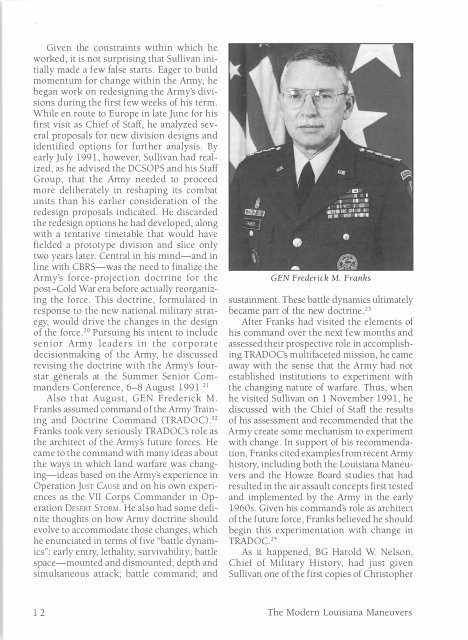The Modern Louisiana Maneuvers - US Army Center Of Military History
The Modern Louisiana Maneuvers - US Army Center Of Military History
The Modern Louisiana Maneuvers - US Army Center Of Military History
You also want an ePaper? Increase the reach of your titles
YUMPU automatically turns print PDFs into web optimized ePapers that Google loves.
Given the constraints within which he<br />
worked, it is not surprising that Sullivan initially<br />
made a few false starts. Eager to build<br />
momentum for change within the <strong>Army</strong>, he<br />
began work on redesigning the <strong>Army</strong>'s divisions<br />
during the first few weeks of his term.<br />
While en route to Europe in late June for his<br />
first visit as Chief of Staff, he analyzed several<br />
proposals for new division deSigns and<br />
identified options for further analysis. By<br />
early July 1991, however, Sullivan had realized,<br />
as he advised the DCSOPS and his Staff<br />
Group, that the <strong>Army</strong> needed to proceed<br />
more deliberately in reshaping its combat<br />
units than his earlier consideration of the<br />
redesign proposals indicated. He discarded<br />
the redesign options he had developed, along<br />
with a tentative timetable that would have<br />
fielded a prototype division and slice only<br />
two years later. Central in his mind-and in<br />
line with CBRS-was the need to finalize the<br />
<strong>Army</strong>'s force-proj ection doctrine for the<br />
post-Cold War era before actually reorganizing<br />
the force. This doctrine, formulated in<br />
response to the new national military strategy,<br />
would drive the changes in the design<br />
of the force. 2o Pursuing his intent to include<br />
senior <strong>Army</strong> leaders in the corporate<br />
decisionmaking of the <strong>Army</strong>, he discussed<br />
revising the doctrine with the <strong>Army</strong>'s fourstar<br />
generals at the Summer Senior Commanders<br />
Conference, 6-8 August 1991. 21<br />
Also that August, GEN Frederick M.<br />
Franks assumed command of the <strong>Army</strong> Training<br />
and Doctrine Command (TRADOC).22<br />
Franks took very seriously TRADOCs role as<br />
the architect of the <strong>Army</strong>'s future forces. He<br />
came to the command with many ideas about<br />
the ways in which land warfare was changing-ideas<br />
based on the <strong>Army</strong>'s experience in<br />
Operation J<strong>US</strong>T CA<strong>US</strong>E and on his own experiences<br />
as the VII Corps Commander in Operation<br />
DESERT STORM. He also had some definite<br />
thoughts on how <strong>Army</strong> doctrine should<br />
evolve to accommodate those changes, which<br />
he enunciated in terms of five "battle dynamics":<br />
early entry, lethality, survivability; battle<br />
space-mounted and dismounted; depth and<br />
simultaneous attack; battle command; and<br />
12<br />
GEN Frederick M. Franks<br />
sustainment. <strong>The</strong>se battle dynamiCS ultimately<br />
became part of the new doctrine 23<br />
After Franks had visited the elements of<br />
his command over the next few months and<br />
assessed their prospective role in accomplishing<br />
TRADOCs multifaceted mission, he came<br />
away with the sense that the <strong>Army</strong> had not<br />
established institutions to experiment with<br />
the changing nature of warfare. Thus, when<br />
he visited Sullivan on 1 November 1991, he<br />
discussed with the Chief of Staff the results<br />
of his assessment and recommended that the<br />
<strong>Army</strong> create some mechanism to experiment<br />
with change. In support of his recommendation,<br />
Franks cited examples from recent <strong>Army</strong><br />
history, including both the <strong>Louisiana</strong> <strong>Maneuvers</strong><br />
and the Howze Board studies that had<br />
resulted in the air assault concepts first tested<br />
and implemented by the <strong>Army</strong> in the early<br />
1960s. Given his command's role as architect<br />
of the future force, Franks believed he should<br />
begin this experimentation with change in<br />
TRADOC 24<br />
As it happened, BG Harold W Nelson,<br />
Chief of <strong>Military</strong> <strong>History</strong>, had just given<br />
Sullivan one of the first copies of Christopher<br />
<strong>The</strong> <strong>Modern</strong> <strong>Louisiana</strong> <strong>Maneuvers</strong>
















